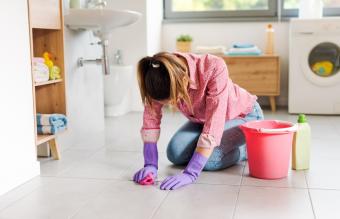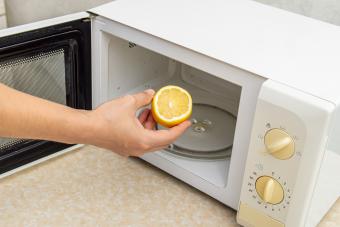
Your kiddo left Mr. Wiggles outside, and now he's a little moldy! Don't throw away your child's best bud! That's not the only option. Grab a few household staples and learn how to get mold off of stuffed animals. This might take a little teddy bear surgery on your part, but you've got this.
Step-by-Step Method to Remove Mold From Washable Stuffed Animals
Stuffed toys are plush, huggable, and full of childhood memories. They're also full of germs and sometimes even mold, so you need a few tips to get these treasured toys mold-free. If the mold is extensive, consider taking it to a professional or putting it in the trash, especially those toys that get a lot of snuggle time with your kiddo. If you've got light mold or stuffies that are more for show, grab a few supplies.
- Rubber gloves
- Scissors
- Mild laundry detergent
- White vinegar
- Hydrogen peroxide or hydrogen bleach (OxiClean)
- Pillowcase or mesh bag
- Fabric softener (optional)
- Old toothbrush
- Towel
- Stuffing
- Sewing kit
1. Remove the Stuffing
Most plush toys are filled with stuffing - it's what makes them so squishable. Unfortunately, mold penetrates that beloved fluff. The mold can also start in the fluff. You'll only notice it when it makes its way to the outside. To be on the safe side, remove the stuffing and replace it.
- Glove up.
- Snip a few seams.
- Pull out the stuffing.
- Throw all the stuffing away.
2. Throw It in the Washer or Handwash
The first thing you need to figure out after removing the stuffing is whether the stuffed toy can handle machine washing. Newer stuffed toys or ones that are pretty sturdy do fine in the washer. If your child's toy is threadbare or precious, then you might want to move on to hand washing.

- Soak the toy in hot water, a tablespoon or two of detergent, and a cup of white vinegar.
- Allow it to soak for at least one hour.
- Wring out the water.
- Put the toy in a pillowcase.
- Add the toy to the washing machine. (For a top loader with an agitator, you need to add a few towels to keep it balanced.)
- Wash the toy in hot water with the recommended amount of laundry detergent and a cup of hydrogen peroxide or the recommended amount of hydrogen bleach.
- Add fabric softener or white vinegar to the wash to keep the softness of the plush.
- Add to the dryer.
- Make sure it's completely dry before handling.
Some extra-loved toys wouldn't stand a chance if you threw them in the washer, such as the Cabbage Patch you got from your grandma or the stuffed bear your daughter has had since she was born. It's too risky that the agitator, even on gentle, could harm them. So, you'll want to opt for a good ole' handwashing.

- Fill a sink with hot water.
- Add the recommended amount of detergent, typically a tablespoon or so, and a cup of white vinegar.
- Use the toothbrush to scrub away any visible mold.
- Agitate in the water.
- Allow the toy to soak for at least an hour.
- Rinse the stuffed toy completely.
- Roll the toy in a towel to remove as much water as possible.
- Allow it to dry on a line or in front of a window in the sun until completely dry.
Be sure the toy is completely dry before continuing.
3. Re-Stuff and Sew Closed
It's essential you make sure the plush toy is dry inside and out before re-stuffing, or you could wind up with more mold.
- Re-stuff the toy with new stuffing once it is clean and dry.
- Sew the area closed tightly.
How to Remove Mold From Non-Washable Stuffed Animals
You've got a toy with a speaker. Well, you can't just throw that gal in the wash. So, you need to get rid of the mold without disrupting the electronics. It's a bit trickier but doable with the right cleaners. Follow these steps to clean a stuffed animal with a voice box.
If you have a stuffed animal that can't be laundered for some other reason, you can spot clean it with so it looks better, but understand that if you can't unstuff and wash the toy, it needs to become a display plushie and not one your child plays with anymore because its stuffing may still be moldy. To spot clean these stuffies, you'll need:
- Toothbrush
- White vinegar
- Spray bottle
- Baking soda
- Plastic bag

- Brush away any visible mold particles outside in the fresh air.
- Spray down the entire toy with straight white vinegar.
- Place it in a bag with a cup of baking soda.
- Shake the toy for a minute or two.
- Allow it to sit for about an hour.
- Take out the toy and brush it off.
- Let it sit in the sun for at least eight hours.
- Shake to remove any remaining baking soda.
- If there is still any trace of mold, repeat the process.
Tips to Avoid Mold on Stuffed Toys
It's hard not to get attached to your stuffed animals, especially for kids. They become best friends and take adventures together. It would break their heart if Doodles suddenly disappeared. To avoid that experience, prevention is the best cure. Get a few tips for how to keep stuffed toys mold-free.
- Make sure the toy is completely dry after washing or cleaning.
- Put toys that accidentally get wet out on a line in the sun or throw them in the dryer until completely dry.
- Clean toys regularly to avoid dirt and bacteria build-up.
- Spritz toys with white vinegar or rubbing alcohol to kill mold spores and bacteria.
- Try to avoid children chewing on stuffed toys.
- Throw it out if in doubt.
How to Wash a Stuffed Toy With Mold
You don't want to take any chances with your child's health. But there are just some stuffies you can't throw away without repercussions. You have the tools it takes to get them clean again. Just let the kiddo know Mr. Wiggles is having a spa day and will be back with an amazing story!







